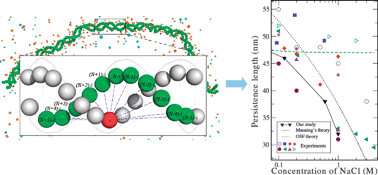Numerous theoretical and experimental studies disagree on the impact of surrounding mobile ions on DNA conformational flexibility at high salt content. Specifically, it is not clear how the DNA persistence length varies when concentration of monovalent mobile ions is increased beyond the physiological value of ∼0.1 M. In the present Communication we address this biologically important issue computationally by means of molecular dynamics simulations. We utilize our recently developed chemically accurate coarse-grained model for the double-stranded DNA with explicit mobile ions. We find that in a range of moderate-to-high ionic concentrations, ∼0.1–1 M, DNA persistence length drops noticeably by ∼25%. Our results contradict some experimental works and the celebrated theory of Odijk, Skolnick and Fixman (Skolnick et al., Macromolecules, 1977, 10, 944), suggesting a negligible variation of DNA persistence length at these concentrations. On the other hand, our findings are in near quantitative agreement with a number of other theoretical and experimental studies. Combined with our recent work on elucidating the role of elastic and electrostatic effects in maintaining DNA shape, the results reported here may indicate that conceptually new understanding of DNA rigidity needs to be developed.

You have access to this article
 Please wait while we load your content...
Something went wrong. Try again?
Please wait while we load your content...
Something went wrong. Try again?


 Please wait while we load your content...
Please wait while we load your content...